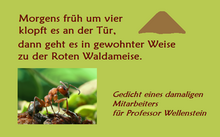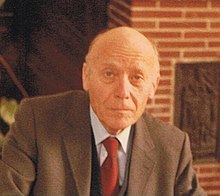Gustav Wellenstein
Gustav Wellenstein (born July 27, 1906 in Trier , † August 14, 1997 in Freiburg im Breisgau ) was a German forest scientist . He had been a professor at the Albert Ludwig University of Freiburg since 1957 and was director of the Forest Zoological Institute until his retirement in 1973. The forest zoologist emerged primarily with entomological work. The study Die Nun in Ostpreußen (1942), one of the most extensive monographs on an insect species, is famous . Wellenstein was part of the management of the forestry experimental and research institute in Freiburg.
Live and act
The forester Gustav Wellenstein concentrated on entomological questions early on. In 1931/32 he examined a nun gradation in Coburg and undertook studies on the ecology of the pine owl as an assistant at the Zoological Institute in Hannoversch Münden , headed by Hermann Eidmann . When the beginning of a large gradation of nuns became apparent in East Prussia in the summer of 1933 , which threatened the extensive pine and spruce populations there, the Prussian state forest administration decided to observe the progress of the mass increase over several years . The aim was not only to gain more detailed biological knowledge about the nun, but also to develop suitable diagnosis and control options. After visiting the affected areas, Wellenstein stated in an expert report that the nun had increased significantly in 20 forest offices on a total area of more than 100,000 hectares.
He had identified a strong threat, especially for the Rominter Heide , with 25,000 hectares of contiguous wooden floor area at the time one of the largest German forest areas. It was therefore selected as the observation area, and Hermann Eidmann was responsible for the scientific management of the investigations. As his first assistant, Wellenstein took over the management of a specially built forest station for pest control in Jagdhaus Rominten in April 1934. It was a barrack camp with living and working rooms, from which he and his 37 employees undertook extensive studies, observations and experiments in the surrounding stocks until 1937. This made them pioneers of field research, which at that time was still in its infancy. The investigation methods developed by the forest station served as a model for all subsequent field studies on harmful forest butterflies. The extensive results were published in 1942 in the 682-page book Die Nun in Ostpreußen , the world's first closed representation of insect gradation and its control within forest entomology.
Wellenstein used the sections he wrote to obtain a doctorate in forest science (Dr. forest.) At the Forestry University in Eberswalde in 1943 and at the same time also a doctorate in natural sciences (Dr. rer. Nat.) At the University of Königsberg . Just one year later, he did his habilitation , also in Königsberg .
He then investigated the great bark beetle calamity from 1944 to 1951 in south-west Germany for the South Württemberg-Hohenzollern Forest Directorate , the successful control of which was primarily due to him. In 1954, the results again led to an extensive presentation in book form. In addition, Wellenstein shot a “bark beetle film”, which also received a lot of attention outside of Germany and was used as an educational film . Based on its experience with insects that are harmful to the forest, the South Württemberg-Hohenzollern Forest Directorate founded the Southwest Forest Protection Agency in Ringingen in 1948 , the management of which was transferred to Wellenstein in 1949. After the founding of the state of Baden-Württemberg , the forest protection point was relocated to Wittental and significantly expanded.
In 1955, Wellenstein received a lectureship in forest protection at the Faculty of Natural Sciences and Mathematics (from 1970 Forest Faculty) of the Albert-Ludwigs University of Freiburg , where he was initially an extraordinary professor in 1957, then a full professor in 1960 and was director of the Forest Zoological Institute until his retirement in 1973. He put his research results down in more than 300 publications in various forestry and entomological journals.
Wellenstein has been strongly committed to environmental protection since the 1950s . While he was an advocate of chemical crop protection in his younger years , he was increasingly critical of it. He now specifically investigated questions of environmental pollution by pesticides and other foreign substances and their effects on humans and animals. He summarized his concerns in 1975 in a lecture that was published in 1976 under the title Is our health in danger? A critical review and outlook on chemical plant protection was published in book form. Strongly influenced by Karl Gößwald , the forest zoologist made forest hygiene and biological pest control the focus of his research since the 1950s . Since then, his scientific work has been characterized by the search for hygienically justifiable methods in forest protection and keeping the environment clean.

In order to achieve the most crisis-proof forest stands possible, he primarily relied on preventive methods, such as promoting forest ants in the course of the ant enclosure, bird protection , fertilization and overall silvicultural changes in the forest structure. Wellenstein also paid attention to pest control through the use of viruses and bacteria that are pathogenic to insects .
In addition, the name Wellenstein is familiar to every beekeeper . Because he intensively researched the connections between forest ants, honeydew insects and the forest honey harvest . After years of mapping the forest ants, he drew up bee maps that gave beekeepers information on high-yield locations for their forest honey harvest. Wellenstein published his findings in a series of guest articles for the Allgemeine Deutsche Beekeeper newspaper .
He has received numerous honors for his scientific work, including the Federal Medal of Merit for the Environment and Nature Conservation (BUND) .
Wellenstein worked at the institute almost every day until his death.
Fonts (selection)
- Contributions to the biology of the red wood ant <Formica rufa L.> with special consideration of climatic and forest conditions , [in: Zeitschrift für angewandte Entomologie , 14,1], Berlin 1928
- as editor and major co-author: The nun in East Prussia (1933-1937). Field studies of the forest station for pest control in Jagdhaus Rominten . Monographs on applied entomology, number 15, Parey, Berlin 1942
- as editor and major co-author: The great bark beetle calamity in southwest Germany 1944-1951. Reports and studies on the way of life, epidemiology and control of bark-breeding beetles on spruce and fir , Forest Protection Agency Southwest, Ringingen 1954
- Overview of the forestry important mice and ways of controlling them , Straßenhaus 1962
- Is our health in danger? A critical review and outlook on chemical plant protection , Schwab, Schopfheim 1976, ISBN 3-7964-0021-3
- Forest ants. Their importance, their biology, their protection and protection , Kempten, 1987 (2nd, revised edition, Kempten 1990)
literature
- Rudolf Lühl et al .: Festschrift Gustav Wellenstein . Freiburger Waldschutz-Abhandlungen, Volume 6. Institute for Forest Zoology, Freiburg im Breisgau 1986, ISBN 3-921954-06-1
- H. Ruppertshofen: Professor Wellenstein 80 years old . In: The forest and wood host . 41st year, issue 16 1986, p. 453
- Joachim Schönherr, Jean Pierre Vité : Gustav Wellenstein 80 . In: Allgemeine Forstzeitschrift (AFZ) , volume 41, issue 29/1986, p. 740, ISSN 0002-5860
- Joachim Schönherr: Professor Dr.Dr. Gustav Wellenstein 90 years . In: General forest and hunting newspaper . 167th year, issue 9/10 1996, ISSN 0002-5852 , p. 204
Web links
- Literature by and about Gustav Wellenstein in the catalog of the German National Library
- Biography on the website of the Forest Zoological Institute of the Albert Ludwig University of Freiburg
Individual evidence
- ↑ 50 years of the forestry experimental and research institute in Baden-Württemberg - a look back
- ↑ https://www.zvab.com/servlet/BookDetailsPL?bi=18649646738&searchurl=hl%3Don%26sortby%3D20%26an%3Dgustav%2Bwellenstein
| personal data | |
|---|---|
| SURNAME | Wellenstein, Gustav |
| BRIEF DESCRIPTION | German forest scientist, zoologist and entomologist |
| DATE OF BIRTH | July 27, 1906 |
| PLACE OF BIRTH | trier |
| DATE OF DEATH | August 14, 1997 |
| Place of death | Freiburg in Breisgau |
